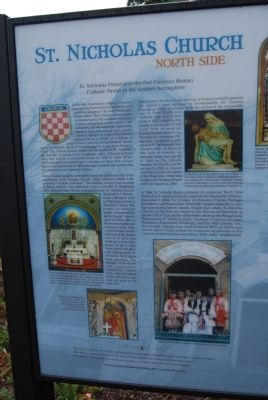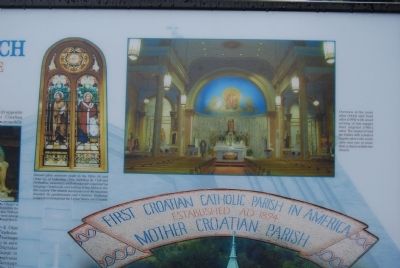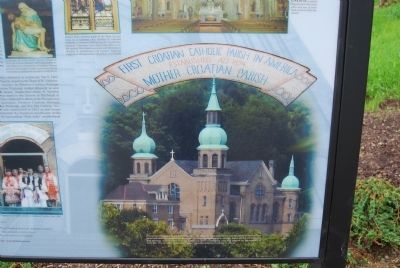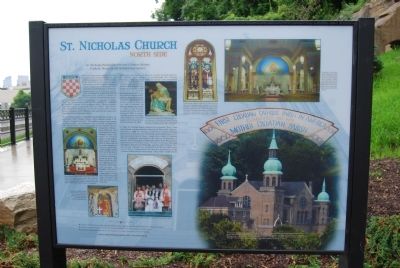Troy Hill in Pittsburgh in Allegheny County, Pennsylvania — The American Northeast (Mid-Atlantic)
St. Nicholas Church
North Side
In the late nineteenth century, Croatian immigrants fled economic hardship and settled in Allegheny City (now Pittsburgh's North Side). The Croatian immigrants were predominantly peasants living in a region comprised of one faith, one nationality, and one language. Community leaders were concerned their people were in danger of neglecting church obligations as a result of a failure to adjust to new customs and petitioned the diocese to establish the first Croatian parish in the New World in 1894. The church council dedicated the parish to St. Nicholas, the Traveler, in honor of its immigrant roots. Church services were first held in a converted house at 1546 E. Ohio Street. With immigration continuing, it was soon evident that a larger church was needed, and in 1899 plans were made for the construction of a permanent and grander edifice.
Many Croatian families contributed physically and financially to the construction of St. Nicholas Church, whose splendor earned it the nickname "Croatian Cathedral." The building contract was awarded to Robert McCain, who submitted a bid of $19,000. In September 1901, Bishop Richard Phelan dedicated the new St. Nicholas Church, designed in a Romanesque-influenced style by Pittsburgh architect, Frederick C. Sauer. Two towers of unequal height, surmounted by onion-shaped domes, stood at either side of the western façade and contained three bells. A third steeple, erected at the rear of the church, served to give the building a secondary façade on its E. Ohio Street (south) elevation and distinguished St. Nicholas from other area churches. The floorplan of the church was longitudinal, containing a central nave with colonnaded aisles on either side and an apse at its east end.
Shortly after the church was erected, a rectory was built opposite the church's west entrance to accommodate the Croatian Franciscan Order of priests. With the arrival of the automobile age, E. Ohio Street was widened from two to four lanes in 1921, requiring the church to be moved 20 feet north from its original foundation and eight feet up. The parish converted the adjacent Duquesne public school to St. Nicholas grammar school in 1931. In honor of Our Lady of Lourdes, an elaborate grotto was erected in 1944 on the hillside between the church and rectory. In 1950, a convent was built to house the sisters of the Franciscan Order who taught in St. Nicholas School until its closure in 1969.
In 1994, St. Nicholas Parish celebrated its centennial. The E. Ohio Street church was permanently closed on the Feast of St. Nicholas, December 6, 2004. For 14 years, the Preserve Croatian Heritage Foundation and Preservation Pittsburgh worked diligently to save this magnificent, historic

Photographed By Mike Wintermantel, June 20, 2015
2. St. Nicholas Church Marker Photo insets
(top right photo)
At the rear left of the church was the Chapel of Our Lady of Seven Sorrows, which was built in the mid-1940s by the Confraternity of Christian Mothers in honor of the parish's golden anniversary and as a memorial to parishioners who died in World War II.
(middle left photo)
Several different types of Italian marble were used in the church's three liturgical altars, altar railings, sanctuary walls, wainscoting, baptismal font, and pulpit. The marble furnishings were installed in 1944 for the parish's golden anniversary as gifts from the congregation.
(bottom left photo)
Statue of the parish's patron St. Nicholas, which was located above the main altar and was among the 15 religious statues donated by parishioners.
(bottom right photo)
Children of St. Nicholas Parish in traditional Croatian dress, 2002.
(footnotes)
In 1976, St. Nicholas Church, North Side was named a historic landmark by the Pittsburgh History and Landmarks Foundation.
In 1996, St. Nicholas Church, North Side was determined eligible for the National Register of Historic Places. In 2001, St. Nicholas Church, North Side was designated as a Historic Structure by the City of Pittsburgh.
At the rear left of the church was the Chapel of Our Lady of Seven Sorrows, which was built in the mid-1940s by the Confraternity of Christian Mothers in honor of the parish's golden anniversary and as a memorial to parishioners who died in World War II.
(middle left photo)
Several different types of Italian marble were used in the church's three liturgical altars, altar railings, sanctuary walls, wainscoting, baptismal font, and pulpit. The marble furnishings were installed in 1944 for the parish's golden anniversary as gifts from the congregation.
(bottom left photo)
Statue of the parish's patron St. Nicholas, which was located above the main altar and was among the 15 religious statues donated by parishioners.
(bottom right photo)
Children of St. Nicholas Parish in traditional Croatian dress, 2002.
(footnotes)
In 1976, St. Nicholas Church, North Side was named a historic landmark by the Pittsburgh History and Landmarks Foundation.
In 1996, St. Nicholas Church, North Side was determined eligible for the National Register of Historic Places. In 2001, St. Nicholas Church, North Side was designated as a Historic Structure by the City of Pittsburgh.
Erected 2015 by Preserve Croatian Heritage Foundation.
Topics. This historical marker is listed in these topic lists: Architecture • Churches & Religion • Settlements & Settlers. A significant historical month for this entry is January 2013.
Location. 40° 27.503′ N, 79° 59.189′ W. Marker is in Pittsburgh, Pennsylvania, in Allegheny County. It is in Troy Hill. Marker can be reached from Walkway to St. Nicholas Church Historic Site, 0.7 miles south of 31st Street Bridge. Located at the St. Nicholas Church Historic Site. Touch for map. Marker is in this post office area: Pittsburgh PA 15212, United States of America. Touch for directions.
Other nearby markers. At least 8 other markers are within walking distance of this marker. St. Nicholas Roman Catholic Croatian Church, North Side (here, next to this marker); Our Lady of Lourdes Grotto (here, next to this marker); Mala Jaska (here, next to this marker); St. Nicholas Church and Mala Jaska

Photographed By Mike Wintermantel, June 20, 2015
3. St. Nicholas Church Marker Photo insets
(top left photo)
Stained glass windows made by the Films Art and Glass Co. of Columbus, Ohio, depicting Ss. Cyril and Methodius, missionary brothers who are venerated for bringing Christianity and writing to the Slavs in the 9th century. The church contained over 40 windows donated by parishioners and Croatian Fraternal Lodges from throughout the United States and Canada.
(top right photo)
Overview of the main altar (1944) and front altar (1979) with wood carving of last supper from original (1901) altar. The mural of God the Father with a host of angels above the main altar was one of more that a dozen within the church.
Stained glass windows made by the Films Art and Glass Co. of Columbus, Ohio, depicting Ss. Cyril and Methodius, missionary brothers who are venerated for bringing Christianity and writing to the Slavs in the 9th century. The church contained over 40 windows donated by parishioners and Croatian Fraternal Lodges from throughout the United States and Canada.
(top right photo)
Overview of the main altar (1944) and front altar (1979) with wood carving of last supper from original (1901) altar. The mural of God the Father with a host of angels above the main altar was one of more that a dozen within the church.

Photographed By Mike Wintermantel, June 20, 2015
4. St. Nicholas Church Marker Photo inset
A source of inspiration to the faithful for over 100 years, St. Nicholas Church was the center of spiritual and social activities for Croatians in Allegheny City and served as a place to worship, learn, secure employment, find spouses, receive news from the homeland, hold celebrations, and find support for the conduct of daily life. The ca. 1901 church and rectory were designed by Frederick C. Sauer.
Credits. This page was last revised on February 2, 2023. It was originally submitted on June 20, 2015, by Mike Wintermantel of Pittsburgh, Pennsylvania. This page has been viewed 566 times since then and 45 times this year. Photos: 1, 2, 3, 4. submitted on June 20, 2015, by Mike Wintermantel of Pittsburgh, Pennsylvania.
